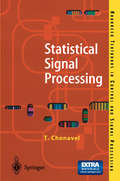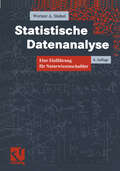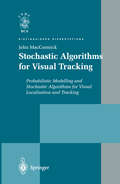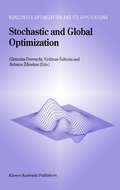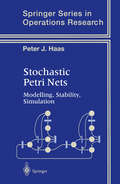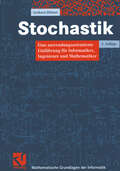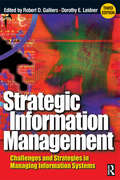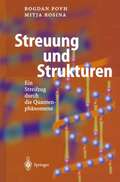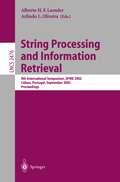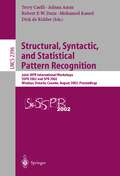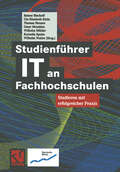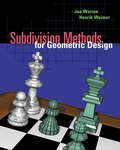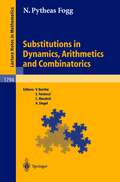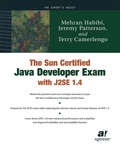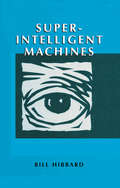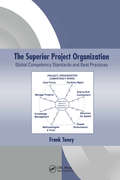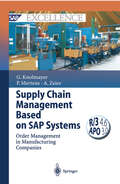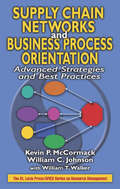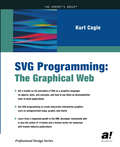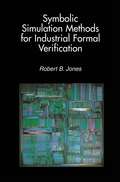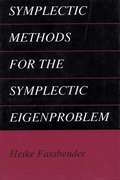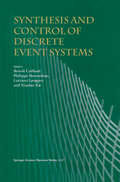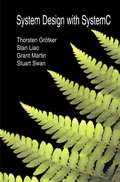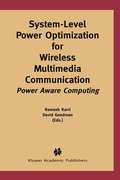- Table View
- List View
Statistical Signal Processing: Modelling and Estimation (Advanced Textbooks in Control and Signal Processing)
by T. ChonavelThe only book on the subject at this level, this is a well written formalised and concise presentation of the basis of statistical signal processing. It teaches a wide variety of techniques, demonstrating how they can be applied to many different situations.
Statistische Datenanalyse: Eine Einführung für Naturwissenschaftler
by Werner StahelDiese Einführung in die statistische Datenanalyse ist für Studierende gedacht, die sich ein vertieftes Verständnis für statistische Problemstellungen erarbeiten wollen, ohne tief in die Mathematik einsteigen zu müssen. Dazu bilden zahlreiche Beispiele aus allen Teilen der Naturwissenschaften und der Technik die Grundlage.
Stochastic Algorithms for Visual Tracking: Probabilistic Modelling and Stochastic Algorithms for Visual Localisation and Tracking (Distinguished Dissertations)
by John MacCormickA central problem in computer vision is to track objects as they move and deform in a video sequence. Stochastic algorithms -- in particular, particle filters and the Condensation algorithm -- have dramatically enhanced the state of the art for such visual tracking problems in recent years. This book presents a unified framework for visual tracking using particle filters, including the new technique of partitioned sampling which can alleviate the "curse of dimensionality" suffered by standard particle filters. The book also introduces the notion of contour likelihood: a collection of models for assessing object shape, colour and motion, which are derived from the statistical properties of image features. Because of their statistical nature, contour likelihoods are ideal for use in stochastic algorithms. A unifying theme of the book is the use of statistics and probability, which enable the final output of the algorithms presented to be interpreted as the computer's "belief" about the state of the world. The book will be of use and interest to students, researchers and practitioners in computer vision, and assumes only an elementary knowledge of probability theory.
Stochastic and Global Optimization (Nonconvex Optimization and Its Applications #59)
by G. Dzemyda V. Saltenis A. 381 IlinskasIn the paper we propose a model of tax incentives optimization for inve- ment projects with a help of the mechanism of accelerated depreciation. Unlike the tax holidays which influence on effective income tax rate, accelerated - preciation affects on taxable income. In modern economic practice the state actively use for an attraction of - vestment into the creation of new enterprises such mechanisms as accelerated depreciation and tax holidays. The problem under our consideration is the following. Assume that the state (region) is interested in realization of a certain investment project, for ex- ple, the creation of a new enterprise. In order to attract a potential investor the state decides to use a mechanism of accelerated tax depreciation. The foll- ing question arise. What is a reasonable principle for choosing depreciation rate? From the state’s point of view the future investor’s behavior will be rat- nal. It means that while looking at economic environment the investor choose such a moment for investment which maximizes his expected net present value (NPV) from the given project. For this case both criteria and “investment rule” depend on proposed (by the state) depreciation policy. For the simplicity we will suppose that the purpose of the state for a given project is a maximi- tion of a discounted tax payments into the budget from the enterprise after its creation. Of course, these payments depend on the moment of investor’s entry and, therefore, on the depreciation policy established by the state.
Stochastic Petri Nets: Modelling, Stability, Simulation (Springer Series in Operations Research and Financial Engineering)
by Peter J. HaasWritten by a leading researcher this book presents an introduction to Stochastic Petri Nets covering the modeling power of the proposed SPN model, the stability conditions and the simulation methods. Its unique and well-written approach provides a timely and important addition to the literature. Appeals to a wide range of researchers in engineering, computer science, mathematics and OR.
Stochastik: Eine anwendungsorientierte Einführung für Informatiker, Ingenieure und Mathematiker (Mathematische Grundlagen der Informatik)
by Gerhard HübnerDas Buch soll Informatiker, Ingenieure und Mathematiker in die Lage versetzen, konkrete Vorgänge mit Zufallseinfluss in den wesentlichen Aspekten zu verstehen, zu modellieren und daraus Prognosen und Entscheidungshilfen abzuleiten. Neu ist die Einbeziehung von Modellen und Bewertungen für Bedienungsprobleme und Kommunikationsnetze auf elementarem Niveau. Die dritte Auflage enthält einige strukturelle und inhaltliche Verbesserungen, insbesondere die vorgezogene Einführung von Zufallsvariablen und überarbeitete Beweise im Abschnitt über Bedienungsnetzwerke.
Strategic Information Management: Challenges And Strategies In Managing Information Systems (Management Reader Ser.)
by Robert D. Galliers Dorothy E Leidner'Strategic Information Management' has been completely up-dated to reflect the rapid changes in IT and the business environment since the publication of the second edition. Half of the readings in the book have been replaced to address current issues and the latest thinking in Information Management. It goes without saying that Information technology has had a major impact on individuals, organizations and society over the past 50 years or so. There are few organizations that can afford to ignore IT and few individuals who would prefer to be without it. As managerial tasks become more complex, so the nature of the requiredinformation systems (IS) changes - from structured, routine support to ad hoc, unstructured, complex enquiries at the highest levels of management.As with the first and second editions, this third edition of 'Strategic Information Management: Challenges and strategies in managing informationsystems' aims to present the many complex and inter-related issues associated with the management of information systems. The book provides a rich source of material reflecting recent thinking on the key issues facing executives in information systems management. It draws from a wide range of contemporary articles written by leading experts from North America and Europe.'Strategic Information Management' is designed as a course text for MBA, Master's level students and senior undergraduate students taking courses in information management. It provides a wealth of information and references for researchers in addition.
Strategic Information Management
by Robert D. Galliers Dorothy E Leidner'Strategic Information Management' has been completely up-dated to reflect the rapid changes in IT and the business environment since the publication of the second edition. Half of the readings in the book have been replaced to address current issues and the latest thinking in Information Management. It goes without saying that Information technology has had a major impact on individuals, organizations and society over the past 50 years or so. There are few organizations that can afford to ignore IT and few individuals who would prefer to be without it. As managerial tasks become more complex, so the nature of the requiredinformation systems (IS) changes - from structured, routine support to ad hoc, unstructured, complex enquiries at the highest levels of management.As with the first and second editions, this third edition of 'Strategic Information Management: Challenges and strategies in managing informationsystems' aims to present the many complex and inter-related issues associated with the management of information systems. The book provides a rich source of material reflecting recent thinking on the key issues facing executives in information systems management. It draws from a wide range of contemporary articles written by leading experts from North America and Europe.'Strategic Information Management' is designed as a course text for MBA, Master's level students and senior undergraduate students taking courses in information management. It provides a wealth of information and references for researchers in addition.
Streuung und Strukturen: Ein Streifzug durch die Quantenphänomene
by Bogdan Povh Mitja RosinaQuantenphysik mag kompliziert erscheinen, wenn man durch Details den Blick auf größere Zusammenhänge verliert. Sie wird einfach, wenn man durch Anwendung weniger grundlegender Konzepte ein Prinzip offenlegt und Größenordnungen abschätzt. Die Eigenschaften von Quantensystemen (Elementarteilchen, Nukleonen, Atome, Moleküle, Quantengase, Quantenflüssigkeiten und Sterne) werden mit Hilfe elementarer Konzepte und Analogien zwischen diesen Systemen dargestellt. Die Wahl der Themen entspricht dem Themenkatalog für die mündliche Diplomprüfung. Das Buch ist vor allem als Vorbereitung auf die mündliche Diplomprüfung gedacht. Einige der Kapitel sind jedoch weit über den Rahmen des Prüfungsniveaus ausgebaut worden, so daß das Buch auch für fertige Physiker von Interesse sein sollte.
String Processing and Information Retrieval: 9th International Symposium, SPIRE 2002, Lisbon, Portugal, September 11-13, 2002 Proceedings (Lecture Notes in Computer Science #2476)
by Alberto H. F. Laender Arlindo L. OliveiraThis volume of the Lecture Notes in Computer Science series provides a c- prehensive, state-of-the-art survey of recent advances in string processing and information retrieval. It includes invited and research papers presented at the 9th International Symposium on String Processing and Information Retrieval, SPIRE2002, held in Lisbon, Portugal. SPIREhas its origins in the South Am- ican Workshop on String Processing which was ?rst held in Belo Horizonte, Brazil, in 1993. Starting in 1998, the focus of the workshop was broadened to include the area of information retrieval due to its increasing relevance and its inter-relationship with the area of string processing. The call for papers for SPIRE2002 resulted in the submission of 54 papers from researchers around the world. Of these, 19 were selected for inclusion in the program (an acceptance rate of 35%). In addition, the Program Committee decided to accept six other papers, considered as describing interesting ongoing research, in the form of short papers. The authors of these 25 papers came from 18 di?erent countries (Argentina, Australia, Brazil, Canada, Czech Republic, Chile, Colombia, Finland, France, Germany, Japan, Italy, Mexico, Saudi Arabia, Switzerland, Spain, United Kingdom, and USA).
Structural, Syntactic, and Statistical Pattern Recognition: Joint IAPR International Workshops SSPR 2002 and SPR 2002, Windsor, Ontario, Canada, August 6-9, 2002. Proceedings (Lecture Notes in Computer Science #2396)
by Terry Caelli Adnan Amin Robert P. W. Duin Mohamed Kamel Dick De RidderThis volume contains all papers presented at SSPR 2002 and SPR 2002 hosted by the University of Windsor, Windsor, Ontario, Canada, August 6-9, 2002. This was the third time these two workshops were held back-to-back. SSPR was the ninth International Workshop on Structural and Syntactic Pattern Recognition and the SPR was the fourth International Workshop on Statis- cal Techniques in Pattern Recognition. These workshops have traditionally been held in conjunction with ICPR (International Conference on Pattern Recog- tion), and are the major events for technical committees TC2 and TC1, resp- tively, of the International Association of Pattern Recognition (IAPR). The workshops were held in parallel and closely coordinated. This was an attempt to resolve the dilemma of how to deal, in the light of the progressive specialization of pattern recognition, with the need for narrow-focus workshops without further fragmenting the ?eld and introducing yet another conference that would compete for the time and resources of potential participants. A total of 116 papers were received from many countries with the submission and reviewingprocesses beingcarried out separately for each workshop. A total of 45 papers were accepted for oral presentation and 35 for posters. In addition four invited speakers presented informative talks and overviews of their research. They were: Tom Dietterich, Oregon State University, USA Sven Dickinson, the University of Toronto, Canada Edwin Hancock, University of York, UK Anil Jain, Michigan State University, USA SSPR 2002 and SPR 2002 were sponsored by the IAPR and the University of Windsor.
Studienführer IT an Fachhochschulen: Studieren mit erfolgreicher Praxis
by Rainer Bischoff Uta Elisabeth Klein Thomas Meuser Omar Moudden Wilhelm Mülder Kornelia Spohn Wilhelm WalterDer Student erhält eine zuverlässige und detaillierte Übersicht über das konkrete Studienangebot der Fachhochschule. Gleichzeitig bekommt er konkrete Praktikums- und Karriereoptionen aufgezeigt: Mit spannenden Praktikerportraits und über 70 Firmenprofilen solcher Unternehmen, die die Vorzüge des FH-Studiums für das eigene Unternehmen zu schätzen wissen. Das neue Werk versteht sich als aktuelles und umfassendes Servicehandbuch, Übersicht und Orientierungshilfe für Studienbewerber, Studienanwärter, Fachhochschulstudenten und -absolventen. Es bietet einen detaillierten Einblick in das Studium der IT-Studiengänge an der Fachhochschule und die damit verbundenen Berufs- und Karrierechancen.
Subdivision Methods for Geometric Design: A Constructive Approach (The Morgan Kaufmann Series in Computer Graphics)
by Joe Warren Henrik WeimerSubdivision Methods for Geometric Design provides computer graphics students and designers with a comprehensive guide to subdivision methods, including the background information required to grasp underlying concepts, techniques for manipulating subdivision algorithms to achieve specific effects, and a wide array of digital resources on a dynamic companion Web site. Subdivision Methods promises to be a groundbreaking book, important for both advanced students and working professionals in the field of computer graphics.The only book devoted exclusively to subdivision techniquesCovers practical topics including uniform Bezier and B-Spline curves, polyhedral meshes, Catmull-Clark subdivision for quad meshes and objects with sharp creases and pointed verticesA companion website provides example code and concept implementations of subdivision concepts in an interactive Mathematica environment
Substitutions in Dynamics, Arithmetics and Combinatorics (Lecture Notes in Mathematics #1794)
by N. Pytheas FoggA certain category of infinite strings of letters on a finite alphabet is presented here, chosen among the 'simplest' possible one may build, both because they are very deterministic and because they are built by simple rules (a letter is replaced by a word, a sequence is produced by iteration). These substitutive sequences have a surprisingly rich structure.The authors describe the concepts of quantity of natural interactions, with combinatorics on words, ergodic theory, linear algebra, spectral theory, geometry of tilings, theoretical computer science, diophantine approximation, trancendence, graph theory. This volume fulfils the need for a reference on the basic definitions and theorems, as well as for a state-of-the-art survey of the more difficult and unsolved problems.
The Sun Certified Java Developer Exam with J2SE 1.4
by Jeremy Patterson Mehran Habibi Terry CamerlengoPractical instruction helps the reader master new features of Java 1.4 by working through a project similar to what is required to successfully complete the Sun Certified Developer Examination.
Super-Intelligent Machines (Ifsr Ser.)
by Bill HibbardSuper-Intelligent Machines combines neuroscience and computer science to analyze future intelligent machines. It describes how they will mimic the learning structures of human brains to serve billions of people via the network, and the superior level of consciousness this will give them. Whereas human learning is reinforced by self-interests, this book describes the selfless and compassionate values that must drive machine learning in order to protect human society. Technology will change life much more in the twenty-first century than it has in the twentieth, and Super-Intelligent Machines explains how that can be an advantage.
The Superior Project Organization: Global Competency Standards and Best Practices
by Frank ToneyThis text describes global best practices, competencies, and standards of superior project organizations based on research conducted by the Top 500 Project Management Forum. It details the results of seven years of benchmarking and the bottom line value of project organizations in large functional enterprises. The text also highlights enhancements
Supply Chain Management Based on SAP Systems: Order Management in Manufacturing Companies (SAP Excellence)
by Gerhard F. Knolmayer Peter Mertens Alexander ZeierSince SAP is emphasizing recent developments in operations management in its SCM initiative, this book describes the methodological background from the viewpoint of a company using SAP systems. It describes order processing both in an intra- and interorganizational perspective, as well as describing future developments and system enhancements.
Supply Chain Networks and Business Process Orientation: Advanced Strategies and Best Practices
by Kevin P. McCormack William C. JohnsonWith future competitive landscape shifting from competition between companies themselves to trading partner networks, understanding and mastering process design and change is becoming more critical than ever. In order to succeed, companies are starting to weave their key business processes into hard-to-imitate strategic capabilities that distinguis
SVG Programming: The Graphical Web
by Kurt CagleLeading expert Kurt Cagle gives a complete guide to the creation of powerful Scalable Vector Graphics (SVG). Intermingling SVG instruction with insightful discussion of key topics such as coordinate systems and attributes, transformations, animation, and image generation, readers are provided with a comprehensive guide to making the most of this exciting new Web standard.Cagle goes directly into the heart of SVG development after a brief introduction of the SVG standard. Readers are presented with an overview of SVG fundamentals and usage and given numerous examples as a practical introduction to language implementation. This material sets the stage for later chapters, which expand upon this basic material to introduce integral SVG concepts such as transformations, shapes, text manipulation, and the incorporation of images, gradients, patterns and masks. The final chapters demonstrate the true power of SVG, offering insight into animation, interactivity, filters, and automated graphic generation.
Symbolic Simulation Methods for Industrial Formal Verification
by Robert B. JonesThis volume contains two distinct, but related, approaches to the verification problem, both based on symbolic simulation. It describes new ideas that enable the use of formal methods, specifically symbolic simulation, in validating commercial hardware designs of remarkable complexity.
Symplectic Methods for the Symplectic Eigenproblem
by Heike FassbenderThe solution of eigenvalue problems is an integral part of many scientific computations. For example, the numerical solution of problems in structural dynamics, electrical networks, macro-economics, quantum chemistry, and c- trol theory often requires solving eigenvalue problems. The coefficient matrix of the eigenvalue problem may be small to medium sized and dense, or large and sparse (containing many zeroelements). In the past tremendous advances have been achieved in the solution methods for symmetric eigenvalue pr- lems. The state of the art for nonsymmetric problems is not so advanced; nonsymmetric eigenvalue problems can be hopelessly difficult to solve in some situations due, for example, to poor conditioning. Good numerical algorithms for nonsymmetric eigenvalue problems also tend to be far more complex than their symmetric counterparts. This book deals with methods for solving a special nonsymmetric eig- value problem; the symplectic eigenvalue problem. The symplectic eigenvalue problem is helpful, e.g., in analyzing a number of different questions that arise in linear control theory for discrete-time systems. Certain quadratic eigenvalue problems arising, e.g., in finite element discretization in structural analysis, in acoustic simulation of poro-elastic materials, or in the elastic deformation of anisotropic materials can also lead to symplectic eigenvalue problems. The problem appears in other applications as well.
Synthesis and Control of Discrete Event Systems
by Philippe Darondeau Luciano Lavagno Xiaolan Xie Benoît CaillaudThis book aims at providing a view of the current trends in the development of research on Synthesis and Control of Discrete Event Systems. Papers col lected in this volume are based on a selection of talks given in June and July 2001 at two independent meetings: the Workshop on Synthesis of Concurrent Systems, held in Newcastle upon Tyne as a satellite event of ICATPN/ICACSD and organized by Ph. Darondeau and L. Lavagno, and the Symposium on the Supervisory Control of Discrete Event Systems (SCODES), held in Paris as a satellite event of CAV and organized by B. Caillaud and X. Xie. Synthesis is a generic term that covers all procedures aiming to construct from specifications given as input objects matching these specifications. The ories and applications of synthesis have been studied and developped for long in connection with logics, programming, automata, discrete event systems, and hardware circuits. Logics and programming are outside the scope of this book, whose focus is on Discrete Event Systems and Supervisory Control. The stress today in this field is on a better applicability of theories and algorithms to prac tical systems design. Coping with decentralization or distribution and caring for an efficient realization of the synthesized systems or controllers are of the utmost importance in areas so diverse as the supervision of embedded or man ufacturing systems, or the implementation of protocols in software or in hard ware.
System Design with SystemC™
by Thorsten Grötker Stan Liao Grant Martin Stuart SwanI am honored and delighted to write the foreword to this very first book about SystemC. It is now an excellent time to summarize what SystemC really is and what it can be used for. The main message in the area of design in the 2001 International Te- nologyRoadmapfor Semiconductors (ITRS) isthat“cost ofdesign is the greatest threat to the continuation ofthe semiconductor roadmap. ” This recent revision of the ITRS describes the major productivity improvements of the last few years as “small block reuse,” “large block reuse ,” and “IC implementation tools. ” In order to continue to reduce design cost, the - quired future solutions will be “intelligent test benches” and “embedded system-level methodology. ” As the new system-level specification and design language, SystemC - rectly contributes to these two solutions. These will have the biggest - pact on future design technology and will reduce system implementation cost. Ittook SystemC less than two years to emerge as the leader among the many new and well-discussed system-level designlanguages. Inmy op- ion, this is due to the fact that SystemC adopted object-oriented syst- level design—the most promising method already applied by the majority of firms during the last couple of years. Even before the introduction of SystemC, many system designers have attempted to develop executable specifications in C++. These executable functional specifications are then refined to the well-known transaction level, to model the communication of system-level processes.
System-Level Power Optimization for Wireless Multimedia Communication: Power Aware Computing
by Ramesh Karri David J. GoodmanThis book focuses on emerging issues in power-aware portable multimedia communications devices beyond low-power electronic design. It compiles system-level power management approaches, from theoretical and simulation studies to experimental test beds related to low power computing, mobile communication and networking.
